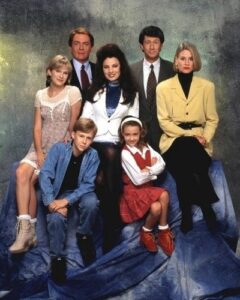
Here’s What ‘The Nanny’ Had To Say About LGBTQ Lives In 1995
The CBS sitcom presented Fran Drescher as a sassy fashionista who held then-progressive views of the queer community, journalist Matt Baume finds.
Nearly 22 years after going off the air, “The Nanny” is must-see TV once again.
The Emmy-winning sitcom, which ran on CBS from 1993 to 1999, joined the HBO Max streaming service last month. Since then, fans and critics have been enthusiastic about binge-watching the antics of Fran Fine and the Sheffield family once again. The show is also proving to be a surprise hit among millennial and Gen Z viewers, many of whom are experiencing it for the first time.

In the latest episode of his popular YouTube series, Seattle-based journalist Matt Baume takes a closer look at why “The Nanny” has preserved its place in pop culture. Of course, there’s the indelible comic timing of star and co-creator Fran Drescher, the “flashy girl from Flushing” who channeled Lucille Ball and Mae West across the show’s six seasons.
And like “The Golden Girls,” the series was refreshingly progressive for its time. Drescher famously fought for Fran Fine to be portrayed as Jewish after producers suggested the character be rewritten as Italian. As Baume points out, the show was also forward-thinking in its treatment of LGBTQ issues, depicting queer characters and their identities as “no big deal.”
He breaks down a Season 2 episode of “The Nanny” called “A Fine Friendship,” in which Fran befriends a male nanny named Kurt (played by Christopher Rich), who she believes is gay. In true sitcom fashion, Fran’s assumptions are based on stereotypes, such as Kurt’s gym-toned body and love of Broadway musicals. Later in the 1995 episode, it’s revealed that Kurt is straight ― in fact, he’s interested in dating Fran ― but he doesn’t flinch at being mistaken for gay.
Watch Matt Baume break down “The Nanny” below.
This flipping of the “gay misunderstanding” trope is one of several examples of what Baume believes sets “The Nanny” apart from other sitcoms of the era, including “Friends” and “Seinfeld.”
“Some genres of television are only just now catching up to what Fran Drescher and ‘The Nanny’ were doing in the mid ’90s,” he said. “It would have been so easy for a sitcom of the time to regard gay characters as shocking, or a source of trouble, or something to be avoided ― and in fact, that’s exactly what a lot of shows did do. It was truly groundbreaking for Fran to include queer storylines in which queerness is not a crisis, particularly when straight characters are not troubled to be mistaken for gay.”
Drescher’s work as an LGBTQ ally extended behind the scenes of “The Nanny” while the series was still on the air, too. She split from the show’s co-creator, Peter Marc Jacobson, after 21 years of marriage in 1999. Though Jacobson came out as gay around the same time, the pair have remained close friends and collaborators, and they teamed up again for TV Land’s “Happily Divorced” in 2011.
“It was truly groundbreaking for Fran to include queer storylines in which queerness is not a crisis, particularly when straight characters are not troubled to be mistaken for gay.”

“It just made sense that [the show] would’ve been embraced by the gay community because it was us creating it and we have that sensibility,” she told Out magazine last year. “I had always been a defender of the gay community and gay civil liberties, and I obviously had a lot of gay friends.”
In recent years, Drescher has floated the idea of a “Nanny” reboot, hinting in interviews that Cardi B. would be her “top choice” as a series star. She has also reportedly joined forces with “Crazy Ex-Girlfriend” star and co-creator Rachel Bloom to adapt the show as a stage musical.
Whether a new incarnation of “The Nanny” materializes on the stage or screen remains to be seen, but for now, Baume is grateful that audiences are finally able to savor the original.
“It took until 2020 for Lifetime and Hallmark to make holiday films about same-sex couples,” he said, “so it’s very impressive that Drescher’s character was completely accepting all the way back in 1993.”
